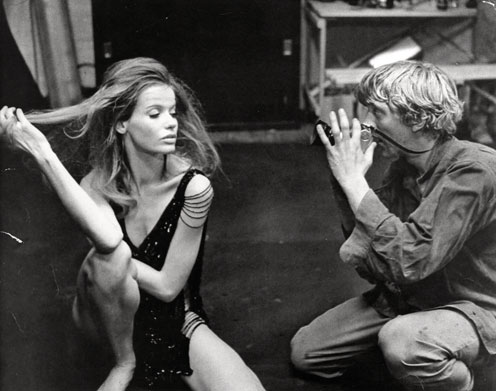Still from Michelangelo Antonioni Blow Up.
Opening this Friday at the James Gallery of the CUNY Graduate Center is an exhibition on Film and Fashion, which celebrates the symbiotic relation the two enjoyed in the 1960s. Titled "Fashion+Film The 1960s Revisited," the exhibition, which is curated by CUNY's Professor Eugenia Paulicelli, is comprised of dress, photographs, and costume designers’ sketches, as well as screenings of film and TV commercials from the decade.
In concert with the exhibition, is a symposium taking place this Friday the 12th. The symposium, which brings together fashion and film academics with costume designers, will explore the impact these two culture industries had on the construction of individual and collective identities, with a particular focus on fashion and film of the 1960s.
Below is the symposium's full schedule
Welcome & Opening remarks
• CUNY, Center for the Humanities
• Louise Wallenberg, University of Stockholm
• Eugenia Paulicelli, CUNY, The Graduate Center
10.10-10:40
• Adriana Berselli, “Working with Antonioni in L’Avventura and Costume Designing for Film”
Q/A, Moderated by Eugenia Paulicelli
10:40- 12:25
Session 1/The Fabric of Film, Fashion and Design
• Sam Rohdie, University of Central Florida, “Hitchcock’s Fabric”
• Marcia Landy, University of Pittsburgh, “Consuming Fashion: Revisioning the 1960s’ Economic Miracle in 1960s Italian Cinema”
• Emily Braun, Hunter College and The Graduate Center, CUNY, “Making Waves: Balla, Pucci and Marine Fantasy in the 1960s”
• Q/A, Moderated by Pat Kirkham, Bard Graduate Center
12:25-1:25/Lunch Break
1:30-3:15
Session 2/Fashioning Urban Space, Cities and Modernity
• Astrid Söderbergh Widding, University of Stockholm, “Fashion Apart: Godard and Fageol in 1960s Paris”
• Vincenzo Maggitti, University of Stockholm, “Blow up: Looking beyond Visibility in the Cult Decade of the 1960s”
• Eugenia Paulicelli, Queens College and The Graduate Center, “Rome: City of Film, City of Fashion”
• Q/A, Moderated by Stella Bruzzi, University of Warwick
3.15-3:30
Coffee Break
3:30-5:15
Session 3/Dress and Masculinity in Film
• Stella Bruzzi, University of Warwick, “Seduced by Beige Slacks: The Fashionable Perversities of Pier Paolo Pasolini’s Teorema”
• Paola Colaiacomo, IUAV, University of Venice, “Poets and Clerks: Male Physicality from Accattone to La prima linea”
• Louise Wallenberg, University of Stockholm, “MAGO’s Magic: Fashioning Sexual (In)difference in the Swedish Cinema of the 1960s”
• Q/A, Moderated by Marcia Landy, University of Pittsburgh
5:15- 6:30
Session 4/Rethinking the 1960s: Stars, Design and Fashion Nostalgia
• Pat Kirkham and Marilyn Cohen, Bard Graduate Center and Cooper Hewitt, “Breakfast at Tiffany's: Fashion, France, Costume and Class”
• Sonya Topolnisky, Bard Graduate Center, “The Mad Men Look: How Mad Men defines 1960s Style”
• Q /A, Moderated by Louise Wallenberg, University of Stockholm
Co-sponsors: The Center for Fashion Studies, University of Stockholm; The Center for the Humanities, Concentration in Fashion Studies, Women’s Studies Certificate Program, Film Studies, CLAGS, The Italian Specialization at The CUNY Graduate Center.
















